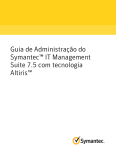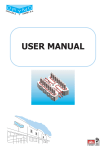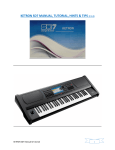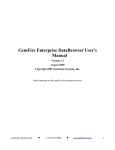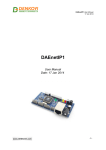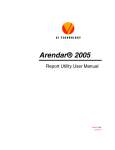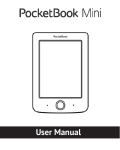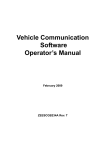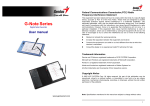Download ExpertDesk 9.0.0 Release Notes
Transcript
ExpertDesk 9.0.0 Release Notes Release Date: November 1 2012 User Manual: The User Manual can be accessed via the help button in ExpertDesk Additions: There is an ExpertDesk Mobile version available. Now your Service Management application can be available anytime, anywhere. Based on the role of the user (Portal User or Process User) the user has access to different functionalities tailored to their use of the application. The ExpertDesk Mobile application allows a Portal User to submit new Requests. A Portal User can also view and edit their submitted Requests (e.g. add progress notes, accept the provided solution, cancel a request) as well as view the Requests submitted by a member of their organization(s). The ExpertDesk Mobile application allows a Process User to view and edit Requests (e.g. perform a state transition, add progress notes) and shows a complete overview of a request on a mobile device. Process users can also view requests of their organisation(s) and have the ability to handle an approval. - After logging in a completely new Start Panel is shown. This means that users now have the ability to create their own queries. An administrator can also build shared queries that are available to all users. A query can be set as default, so that immediately after login the query will be performed automatically. On the Start Panel, three buttons are available to quickly perform the following actions: o Open the New Request form; o Open the Reporting section; o Open the Dashboards. - A new search feature has been added to the header bar of the application. This search feature searches through all requests, including attachments, notes and emails. Indexed attributes: o Ticket ID o Subject o Description o Solution o Process Type o Assigned Group o Assignee o Status - A new search feature has been added to the CMDB. This search feature searches through all CI’s, including attachments and notes. Indexed attributes: o o o o o o o o CI Name CI Type Short Description Model Manufacturer Serial Number Status Owner - A new search feature has been added to the Web shop. This search feature searches through all products. Indexed attributes: o Product Name o Category o Product Description - Data patching functionality has been added to the application. With the auditing option turned on, this feature allows for an easier tracking and transfer of your data changes through your DTAP street. When doing configuration on a test environment that contains a database dump of production the audit will track the changes. You can then define the data patch and use export/import or a web service to transfer the patch to the acceptance environment. There you apply the patch and all changes are applied automatically. When the patch is correct you can easily move the patch to production and apply it again. Of course this assumes no changes in the core data on production. - A Notification Center that collects all messages generated by (a configurable set of) request events can be viewed within the ExpertDesk application. This means that an email address is no longer the only way of communication. A user can choose to subscribe to an event message and can specify whether to receive this message only in the ExpertDesk Notification Center or also as an email. The Notification Center is situated in the header bar and can therefore be accessed throughout the entire application. - When handling a Request a lot of information is gathered. Notes, emails, state transitions and notifications are now chronologically bundled in the Activity Stream. It is possible to filter the Activity Stream on type. - A button has been added to the header bar to create a Request from anywhere in the application. - It is now possible to view a Graphical presentation of your configured Service Routes. A service route is the way a service is handled in the application via SLA’s and OLA’s and by business groups. - It is now possible to view a Graphical presentation of the state transitions within a matrix. - A set of functional roles have been introduced to show/hide certain functionality. These roles can be defined and grouped as a template by an administrator. When creating new user accounts, a role template can be added to the new user. Example: Your Service organization does not use dynamic attributes. An administrator can now simply create a template without the dynamic attribute role and the dynamic attribute functionality will not be visible for end-users. - A more dynamic Reporting module has been added to be able to build Operational Reports at runtime. This feature adds considerable flexibility to build reports without the need for a new deployment of the application. For building new reports knowledge of the query language OQL is required. The reports are still generated by Fusion Charts. - All the CMDB Overview forms have been extended with Import and Export functionality to manage your CI data more efficiently. - Task Templates can be configured to create tasks in your process even more easier and faster. Having a task template available, you simply select the task template from a drop-down list and all necessary fields will be filled in automatically. - When creating a task it is possible to copy attachments of the ticket and/or parent task. - A migration tool for ExpertDesk ARS customers has been developed. This allows for faster migration that off course might need to be adapted for customizations of the customer. - The user statistics module from Mendix has been added to support maintaining the application and tracking usage Removals: - Adding the new ExpertDesk Start Panel has made the CMS function obsolete. The Chat functionality was not up to standard yet. A major revision is planned in the near future. Changes: - ExpertDesk has undergone a major GUI update. Not only the colors and buttons, but a complete restyle of the application has been made. All with one goal: ExpertDesk should be a clean, simple and an easy to use application that is easy on the eye. - The occurrence (schedule) of a Scheduled Request is now part of a Scheduled Request. You do not have to (and cannot) configure separate schedules anymore. - Package products are now Optional products in the Web shop. It is now possible to add an optional product to a product that can be ordered via the Web shop. A user can now choose an optional product instead of always receiving the whole package deal. - A user can enter a wish date when ordering a product via the web shop. If the wish date is earlier than the earliest delivery date, a reason for this wish date is required. - Filling in a location is no longer required when creating a new Request. - The Change Calendar can now show Change requests and Operation requests. It is possible to drill down to the request and even rescheduling of the request by dragging and dropping the request to the new date is now supported. - When adding a ticket or task template to a workflow, you can now add a different Subject and Detailed Description. You now need less templates and have easier configuration. - The number of menu items in the navigation bar has been reduced. Configuration will be easier because the configurable data is grouped in a configuration menu. - Documentation has been extended and is available from within the application. - It is now possible to create a Catalog CI which can be instantiated. This instantiation follows relations to other catalog CI’s to allow for example a standard PC with monitor and keyboard to be instantiated at once. You can instantiate multiple items at once. The instantiation can also relate to existing CI’s, for example licenses or software. The instantiation can follow a naming convention including a number scheme. - Relation types and CI Types can now be configured to allow more flexibility in the CMDB. The types are use in the new configuration of allowed relations, so the CMDB can be configured in more detail. For example a switch can define uplink and downlink ports as CI type and the allowed relation can be that a relation of type network can be between an uplink and a downlink port. Or database of type MSSQL can only be linked to operation system of type windows. Also relation types can be of sort component-relation. This allows for the GUI to present multiple levels of child relations at once, so a switch can be presented with slots, cards and ports in 1 grid. - There is a replace feature that allows replacing a CI of a certain type with another one of the same type and you can select which relations to move to the new CI. This helps when defect CI’s are replaced. - There is a cascaded delete option in the CMDB that will delete a CI including related CI’s. This helps when the CMDB structure contains composed items like a PC with monitor, keyboard and mouse or a switch with slots and cards with ports. - There is a batch relate function to allow relation of large set of CI’s. This is handy when configuring a network infrastructure with patch panels and switches that are connected by large amounts of relations, say 200 lines in a cable. You now can link the switch to the patch panel with this bulk function. - Data Access is enhanced so automatic rules can be applied over more relations. For example relations between processes. - The import/export is enhanced to allow upload/download of a zip file instead of the need to place files on the server. Also the logging is enhanced to see progress, the error messages have been improved, date formats and time zones are supported, enums and Booleans are translated, passwords can be exported (encrypted) and imported (encrypted or clear text), unlimited chars are supported with sizes over 32k, performance and memory usage is enhanced. Performance: - The CMDB Graphical Browser has undergone a considerable performance improvement. Various actions have been made asynchronous for better performance. Drop downs in search forms have been replaced when containing too much data A lot of features like data access and database logging have been made configurable, so if you don’t use them they are not shown and do not take any performance in the background. Fixes: - CC036915: SSO: Fix for http 500 error when an account is not yet synchronized. CC037113: Password should not be required when using autorization via LDAP. CC037265: Creating a Request from an email sometimes results into an error due to an attachment. CC037414: Organization and person not set. CC037461: LDAP: Incorrect synchronization of email address CC038696: When using HTML color codes in email templates, ExpertDesk treats this as a replacement code. CC043158: Exception in Scheduled Event 'FetchIncomingEmailEvent'. CC043355: Sorting of Categories not alphabetically. CC044339: Dashboard does not work when using special characters in group names. Known Issues: - Using ExpertDesk Mobile on a Windows Phone is not supported. It is not possible to drill down the Change Calendar in Week view. When previewing an attachment, the zoom function does not work. When uploading an attachment larger than the maximum allowed file size, a system error will occur. Importing, especially of large XLSX files takes a lot of memory. There is an option to commit to the database by row to save memory usage, but the java-library still takes a considerable amount of memory to load the XLSX into memory.







